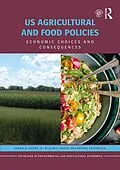This text provides opportunities to "practice the craft" of policy analysis by engaging the reader in realistic case studies and problem-solving scenarios that require the selection and use of applicable investigative techniques. US Agricultural and Food Policies will assist undergraduate students to learn how policy choices impact the overall performance of agricultural and food markets. It encourages students to systematically investigate scenarios with appropriate positive and normative tools. The book emphasizes the importance of employing critical-thinking skills to address the complexities associated with the design and implementation of 21st-Century agricultural and food policies.
Autorentext
Gerald D. Toland, Jr. is a Professor of Economics at Southwest Minnesota State University, USA.
William E. Nganje is a Professor in the Department of Agribusiness and Applied Economics, North Dakota State University, USA.
Raphael Onyeaghala is a Dean of the College of Business, Education, Graduate, and Professional Studies at Southwest Minnesota State University, USA.
Zusammenfassung
Policy analysis is a dynamic process of discovery rather than a passive exercise of memorizing facts and conclusions. This text provides opportunities to "practice the craft" of policy analysis by engaging the reader in realistic case studies and problem-solving scenarios that require the selection and use of applicable investigative techniques. US Agricultural and Food Policies will assist undergraduate students to learn how policy choices impact the overall performance of agricultural and food markets. It encourages students to systematically investigate scenarios with appropriate positive and normative tools. The book emphasizes the importance of employing critical thinking skills to address the complexities associated with the design and implementation of twenty-first-century agricultural and food policies. Students are asked to suspend their personal opinions and emotions, and instead apply research methods that require the careful consideration of both facts and values. The opportunities to build these investigative skills are abundant when we consider the diversity of modern agricultural and food policy concerns. Featuring case studies and critical thinking exercises throughout and supported by a Companion Website with slides, a test bank, glossary, and web/video links, this is the ideal textbook for any agricultural policy class.
Inhalt
Preface
Chapter 1: An introduction to policy analysis
Chapter 2: Twenty-first-century trends, opportunities, and challenges for US agriculture and food systems
Chapter 3: A policy analysis toolbox: methods to investigate agricultural and food market scenarios
Chapter 4: Analyzing economic consequences of farm safety net programs in the 2014 Farm Bill
Chapter 5: The Food Safety Modernization Act (FSMA): evaluating costs and benefits
Chapter 6: US agricultural and food sector connections to the global economy
Chapter 7: Analyzing effects of USDA nutrition programs on hunger and food security in the US
Chapter 8: Economic choices and outcomes for agriculture, natural resources, and the environment
Chapter 9: Research, technology, and the growth of sustainable agricultural production
Chapter 10: Exploring the multi-dimensional aspects of food security
Chapter 11: Twenty-first-century perspectives on rural development
Chapter 12: Current developments and new dynamics influencing agricultural and food policy
Chapter 13: When policies work at cross-purposes: addressing challenges and pursuing opportunities
